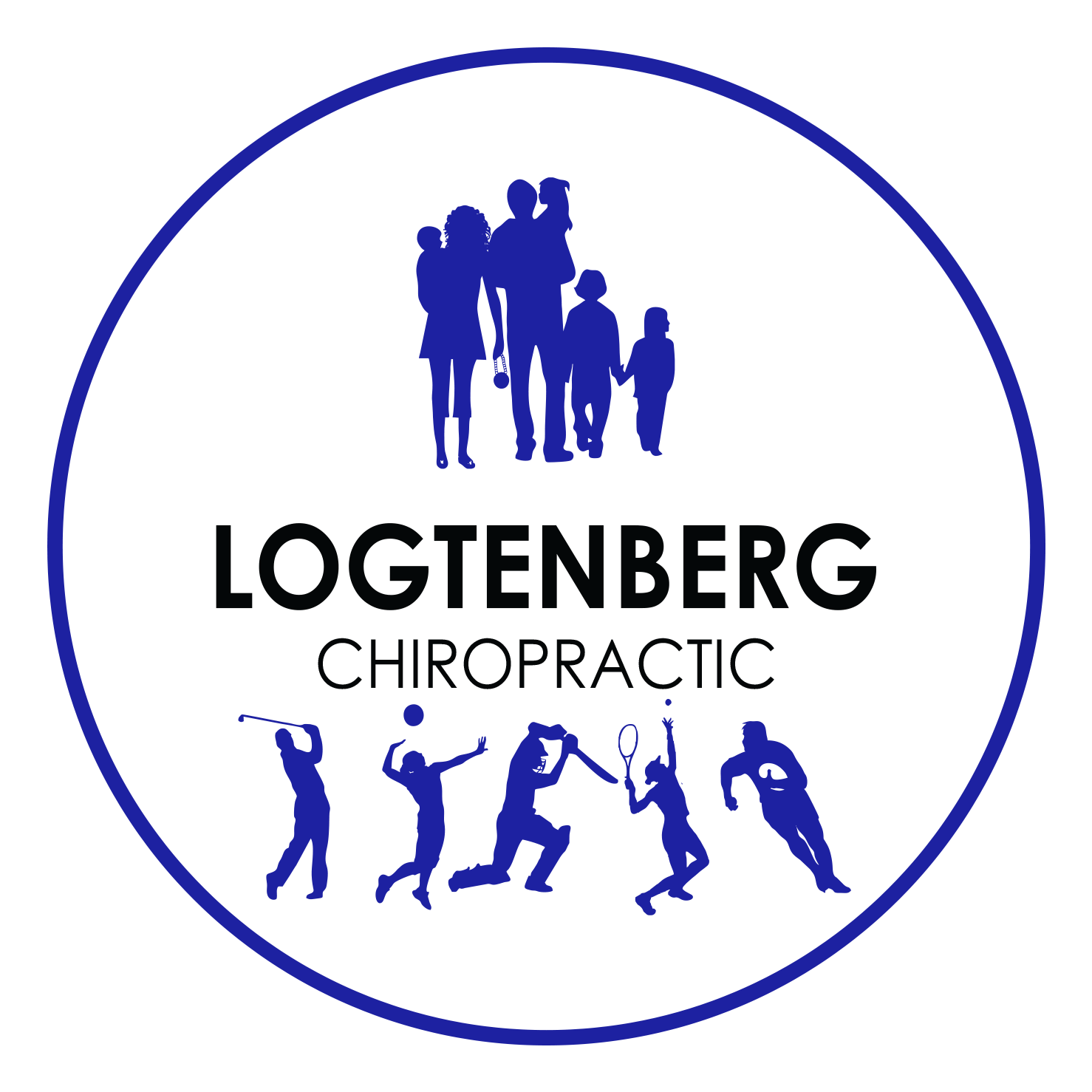Common Conditions Chiropractic Can Treat

Please note that our treatments aren’t limited to the specific conditions listed on this page.
We treat the full spectrum of common chiropractic conditions.
List of Our
Services & Treatments
Make an
Appointment
Upper Limb Conditions
Shoulder

The shoulder is the most mobile joint in the body and this gives the upper limb extensive range of motion but this mobility comes at the expense of stability. Despite the rotator cuff muscles, tendons, ligaments, and the glenoid labrum counteracting the instability, the shoulder is still prone to dysfunction and injuries. Shoulder pain may arise from the shoulder joint itself or from the surrounding muscles, ligaments or tendons. Sometimes other diseases or conditions that affect the organs or other tissues in your chest or abdomen can refer pain to the shoulder. Referred pain generally doesn’t get worse with shoulder movement.
Symptoms and signs of shoulder problems consists of shoulder or arm weakness, limited range of motion of shoulder joint, grating/cracking/snapping sounds, bruising or swelling, muscle spasms, numbness and tingling.
The most common causes of shoulder pain include rotator cuff syndrome, impingement syndrome, frozen shoulder (also called adhesive capsulitis), bursitis, sprains or strains, arthritis, pinched nerves, dislocations, fractures and heart attacks.
Rotator cuff syndrome
The rotator cuff is a group of muscles and their tendons responsible for the stabilization and movement of the shoulder and arm. Rotator cuff dysfunction can be the result of an acute tear/strain from a fall or accident or chronic overuse injuries from repetitive lifting, pushing, pulling, or throwing. Other factors include poor blood supply, wear and tear associated with aging, and calcific invasion of tendons.
Symptoms of rotator cuff injuries are due to the inflammation that is associated with the strain, it causes swelling and leads to pain and decreased range of motion. Depending on the mode of injury the pain can range from mild and insidious to sharp and immediate. It`s often worsened with certain arm movements and at night when lying on the affected shoulder.
Frozen shoulder (Adhesive capsulitis)
A Frozen shoulder, also called adhesive capsulitis, is a shoulder joint that has lost a substantial amount of its range of motion in all directions due to inflammation, scarring, thickening and shrinkage of the capsule that surrounds the joint. Any shoulder injury such as rotator cuff syndrome, tendinitis or bursitis can lead to frozen shoulder due to possible scar formation on the shoulder capsule. The risk of developing frozen shoulder increases in patients diagnosed with diabetes, autoimmune diseases, heart disease, thyroid disease, high cholesterol, arthritis, upper limb trauma and immobilization such as that after surgery.
The symptoms of frozen shoulder can be divided into 3 phases. In the initial freezing phase there is a steady onset of diffuse pain that could last a few weeks or a few months. The pain can continue into the frozen or stiffening phase but diminishes over time. In this phase there is also a progressive loss of range of motion lasting up to a year. During the final phase, called the thawing or regressive phase, there is a gradual increase in range of motion over a period of weeks to months. Oftentimes the other shoulder also develop adhesive capsulitis over a matter of months to years.
Elbow pain
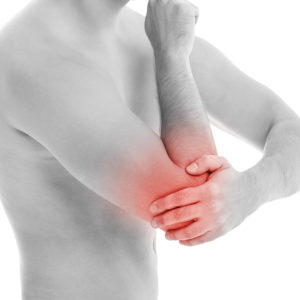
Elbow pain is any type of pain that derives from structures in the elbow joint and/or in structures adjacent to the elbow joint such as the shoulder, upper arm, forearm, and wrist and hand joints. It`s described as sharp, dull, burning, or pressure discomfort or pain that can be intermittent, constant, or shooting, depending on the cause.
The most common causes of elbow pain is as a result of overuse and strain from performing repetitive activities and partaking in sports and gym exercises. Other less common causes are infections, trauma and arthritis.
Chronic overuse places continuous demands on the muscles and tendons that result in tissue damage in the form of microscopic tears. When the body is unable to repair the tears in the tissue as fast as they are being made, it results in inflammation, tenderness and pain. Individuals who perform any activity that involves twisting, gripping or lifting motions in which the forearm muscles are repeatedly contracted against resistance, may develop one or more types of elbow pain. Examples of these activities are pruning bushes, pulling weeds, using a screwdriver, playing violin/tennis/golf, gym exercises (such as push-ups and weightlifting), throwing a frisbee and many more.
Excessive stress on the elbow joint can lead to a ligament or tendon tear or even a dislocation or fracture. Work accidents, contact sports such as rugby, and motor vehicle accidents can lead to irritation and occasionally to severe elbow injury. Trauma to the arm and/or elbow may compromise the blood supply. Trauma and/or repetitive stress may also result in swelling and nerve compression or entrapment.
Due to the elbow pain individuals may use other joints to compensate for the loss of movement. This may result in discomfort or pain in other joints or muscles, such as the shoulder, wrist, forearm, or hand.
Tennis and Golfer`s elbow
Both of these conditions are types of tendinitis, meaning there is inflammation in the tendons of the elbow due to overuse, resulting in pain. In spite of what people think, the conditions doesn’t only occur in tennis and golf players. It is just that an individual is more likely to get them based on the arm movements used in those two sports.
Tennis elbow, also called lateral epicondylitis, involves inflammation of the tendon that attaches to the outer portion of the elbow. Symptoms include a dull achy pain that may radiate from the outside of your elbow into your forearm and wrist. There can be stiffness and a sensation of weakness but the range of motion remains unchanged. There is usually no significant swelling or discoloration. The pain can be triggered by shaking hands, turning a doorknob, holding a cup or gripping an object.
Golfer`s elbow, also called medial epicondylitis, involves inflammation of the tendon that attaches to the inner portion of the elbow. The pain is usually felt on the inner side of your elbow and occasionally extends along the inner side of your forearm. The elbow joint may feel stiff and you may have weakness in your hands and wrists but the range of motion is preserved. Sensations of numbness or tingling radiating into one or two fingers (usually ring & little finger) can also occur.
Spinal Conditions
Spinal Pain

Neck pain
Neck pain (also called cervical pain) is pain that is located between the base of the skull to the upper level of the shoulder blades, the sides of the neck and the throat area down to the level of the collarbone. Any disease or condition that involves the bony cervical spine, intervertebral discs, ligaments around the spine and discs, spinal cord and nerves and the muscles, will result in neck pain.
Common conditions that results in neck pain are degenerative disc disease, neck strain, arthritis, poor posture, neck injury (such as whiplash sustained during a motor vehicle accident), a herniated/ prolapsed disc and a pinched nerve.
Neck pain can be aggravated by movement of the neck or head and has been described as ranging from dull to sharp. Other symptoms related to neck pain includes numbness and/or tingling in the upper extremities, swishing sounds in the head, lightheadedness, dizziness, decreased range of motion, headaches, facial pain, shoulder pain, arm pain and stiff muscles.
Some of the risk factors for neck pain are contact sports, motor vehicle accidents, working in awkward positions, sustained positions, hostile work environment, sleep disturbances, high job strain, age and psychological factors such as stress or anxiety.
Mid back / Upper back pain
Mid or upper back pain (also called thoracic pain) is pain that is located in the area between the base of the neck and down to the bottom of the rib cage. It is less common than neck and low back pain since the spine moves less and doesn’t bear as much load of your body`s weight.
Any disease or condition that involves the bony thoracic spine, intervertebral discs, ligaments around the spine and discs, spinal cord and nerves and the muscles, will result in mid/upper back pain. Common causes are strains or injury to the muscles due to overuse, poor posture, whiplash, arthritis, scoliosis, a herniated/ prolapsed disc and a pinched nerve.
Together with the ribs, the thoracic spine protects your vital organs, such as your heart and lungs, so conditions/diseases related to your internal organs may also present as upper/mid back pain and not just as chest pain. These more serious conditions must always be ruled out first.
Low back pain
Low back pain (also called lumbar pain) is pain that is located in the area between the level of the last rib and the buttocks. Any disease or condition that involves the bony lumbar spine, intervertebral discs, ligaments around the spine and discs, spinal cord and nerves and the muscles, will result in back pain.
Common causes of low back pain include degenerative disc disease, low back strain (due to overuse, improper use or trauma) arthritis, scoliosis, poor posture, a herniated/ prolapsed disc and a pinched nerve (sciatica).
Symptoms associated with low back pain can include numbness and/or tingling in the lower extremities, decreased range of motion, pain in one or both legs, weakness in the lower extremities, joint pain, dizziness and stiff muscles.
Some of the risk factors for low back pain are athletic activity, heavy manual lifting, excessive bending & twisting, whole body vibration, trauma, age, obesity and psychological factors such as stress, anxiety and depression.
Headaches
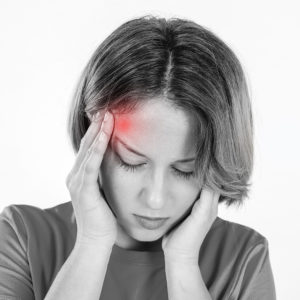
Tension headaches
Although tension headaches are the most frequent type of headache, their exact cause is unknown but is most likely due to the muscles that cover the skull going into spasm. Contributing factors are increased stress, impaired sleep and skipping meals.
Common sites of pain are located at the base of the skull, the temples and the forehead.
Signs and symptoms of tension headaches include:
Pain that is described as cap or band-like tightness and/ or pressure.
The pain varies in intensity but usually it isn’t disabling and sufferers are able to continue their daily activities.
Pain usually affects both sides of the head and is not aggravated by activity.
It occurs sporadically but can also occur frequently and even daily in some people.
Is not associated with an aura, nausea, vomiting or a sensitivity to light and sound.
Tension headaches can trigger migraines and some individuals suffer from both migraines and tension headaches.
Migraines
Migraine headaches are caused by inflammation or irritation of the structures that surround the brain or affects its function. Common symptoms include severe throbbing pain that may be worsened with physical activity and is often located only on 1 side of the head, eye pain, sensitivity to light/sound/smells, nausea and/or vomiting.
They may be triggered by tension headaches, hormonal changes, stress, strong stimuli (like loud noises, bright lights or strong smells), certain foods (red wine, aged cheese, artificial sweeteners, chocolate, dairy, alcohol). Not every individual who suffers from migraines will experience one when exposed to these triggers.
Rebound headaches
Rebound headaches (previously called medication overuse headache) is a condition where the frequent use of pain medications can lead to persistent headaches due to changes in the brain chemistry. The headache may improve for a short period of time after medication is taken but then re-occurs.
Cervicogenic headaches
Pain referred to the head from a source in the neck is called a cervicogenic headache.
Common signs and symptoms are continuous, moderate and non-throbbing pain; concurrent pain in the neck, shoulder and arm; reduced ranges of motion of the neck and provocation of the pain by neck movement.
Whiplash

A whiplash injury occurs following a sudden acceleration-deceleration force that causes unrestrained, rapid forward and backward movement of the head and neck. The sudden motion causes the muscles and ligaments of your neck to extend beyond their typical range of motion, resulting in stretching and/or tearing.
It is most commonly from motor vehicle accidents but can also occur from diving accidents, physical abuse from being punched or shaken, contact sports such as boxing and karate, cycling accidents, falls in which the head suddenly jerks forward and/or backward, as well as a hard blow to the head by a heavy object.
Risks for whiplash injuries are higher in women, people with shorter necks, car seats with a low neck rest and if the collision is from the rear with a heavy vehicle.
The symptoms might not be experienced immediately and can appear a few days later. Common symptoms of an acute whiplash injury include headaches, upper back pain, shoulder pain and paresthesia/ numbness/weakness and/or pain in the arms. Less common symptoms are dizziness, blurred vision, vertigo, fatigue and difficulty swallowing.
If the symptoms persists beyond 4 weeks it is referred to as a subacute whiplash injury and if it persists beyond 12 weeks it’s referred to as chronic whiplash injury. Symptoms can then include depression, anger, frustration, anxiety, insomnia, drug dependency and a hypersensitivity to stimuli that wouldn’t normally cause discomfort or pain.
Herniated disc
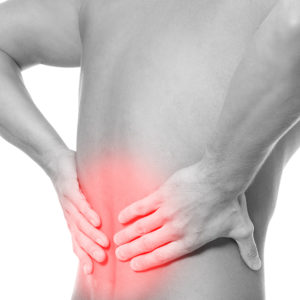
Our spine is made up of vertebra that are stacked on top of each other like building blocks. They are connected to each other via the capsules of the facet joints, ligaments and muscles. In-between the vertebra in the spine there are cartilaginous discs that help cushion and absorb shock and reduce friction between the vertebrae. There are also bony arches attached to the vertebra that protects the spinal cord. A pair of spinal nerves that originates from the spinal cord exits between each vertebra through an opening called the intervertebral foramen.
Each disc is composed of an outer layer of tough cartilage that encloses a softer cartilage in the center. With age and from injuries, the discs can degenerate and show signs of wear and tear (also called degenerative disc disease). These changes can cause the whole disc to bulge or it can cause the softer cartilage to protrude through the weakened tough cartilage layer resulting in a herniated disc. Pain is caused by the irritated nerve roots either from direct compression from the disc or due to inflammation of the nerve roots.
The symptoms depends on what level of the spine the disc has herniated and if there is nerve irritation. Some herniated discs can be asymptomatic or cause mild local pain. Others, depending on the size of the herniation, can result in sharp shooting pain in the distribution of that nerve. The most common level that discs herniate is in the low back between the 4th and 5th lumbar vertebrae and it causes sharp shooting pain down into the buttocks, thigh and into the leg. If the disc herniation is in the neck it can cause sharp shooting pain into one arm, muscle spasms and severe stiffness in the neck. Other symptoms include numbness or tingling and even muscle weakness.
Risk factors for disc herniation comprises of occupation (repetitive lifting, pulling, pushing, bending sideways and twisting); sport activities; excess bodyweight and smoking.
Sciatica

The sciatic nerve is one of the largest nerves in the body and it originates in the low back from the spinal nerves that joins together, it then travels through the buttock / hip area and splits into branches that supplies all the muscles in the lower extremity.
Nerve pain due to compression, irritation or inflammation of the sciatic nerve is called sciatica and it can be felt anywhere on the pathway that the nerve travels. The pain can range from a mild ache to a sharp burny sensation and sometimes it can even feel like an electric shock. Usually only one side of the body is affected. Other symptoms include low back pain, hip pain, buttock pain, burning/tingling/numbness down your leg and weakness of your leg muscles.
The most common reason for sciatica is a lumbar disc herniation causing pressure on the nerve. It can also be the result of nerve irritation from adjacent bone, muscle spasms, infections, tumours, narrow spinal canal, injury or vertebra that has moved forwards.
Risk factors include trauma or injury to the spine, arthritis, degenerative disc disease, obesity, pregnancy, old age, type of work, a sedentary lifestyle and prolonged sitting.
Lower Limb Conditions
Hip
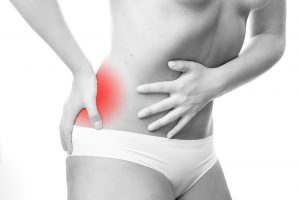
Hip pain can be caused by a wide variety of problems and the exact location of the pain can indicate what the cause is.
Problems within the hip joint itself can result in pain on the inside of your hip or your groin. Hip pain on the outside of your hip, upper thigh or outer buttock is usually caused by problems with muscles, ligaments, tendons and other soft tissues surrounding the hip joint. Pain can also be referred to the hip joint from other areas in the body.
The most common cause of hip pain is when there is inflammation of one of the two bursae (called bursitis), usually due to soft tissue trauma or minor strain. A bursa is like a pouch filled with fluid that lies between moving tissues of the body, usually joints and tendons. They act as a gliding surface to decrease friction and resistance between the different tissues to prevent chafing and damage from occurring.
Other causes of hip pain include arthritis, iliotibial band syndrome, sciatica, ligament sprain, muscle strain, avascular necrosis and fractures.
Symptoms of hip pain depends on the cause and comprises the following: decrease in ranges of motion, limping, groin pain, swelling and warmth over the hip, tenderness of the hip resulting in pain and discomfort when sleeping on the affected side.
Knee
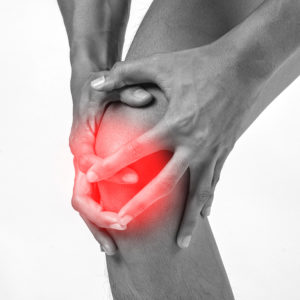
The knee is one of the most frequent body parts that gets injured. Common causes of knee pain include overuse, sprains or strains of the muscles and/or tendons, bursitis, dislocations, fractures and meniscus (disc) tears. Injuries are usually the result of twisting or bending forces that gets applied to the knee or direct impact such as from sport, a fall or motor vehicle/ motor cycle accidents. Knee pain can also be referred from other joints, such as the hip, or can be due to medical conditions such as arthritis or gout.
Some of the signs and symptoms are swelling, stiffness, redness, warm to touch, weakness or instability, popping/crunching or grinding noises, inability to fully bend or straighten the knee, locking of the knee joint, limping and problems with weight bearing like standing.
Risk factors include sport activities that is high impact, when shoes with cleats are worn, contact sports and those where sudden changes of direction is required. Others are high impact exercises, yoga, the elderly, females, excessive weight and insufficient rehabilitation of injuries.
Iliotibal band syndrome:
Iliotibial band syndrome (also called ITB syndrome) is an overuse injury of the band of connective tissue that begins in the pelvic area, runs down the outside of the thigh, crosses the knee and attaches on the top portion of the shin. It results in pain in all of these areas, especially just above the knee joint. The function of the iliotibial band is to stabilize the outside part of the knee during movement, assist in lifting up the leg to the side and when straightening and bending the knee.
ITB syndrome is usually seen in long-distance runners, bicyclists, rowers and other athletes who repeatedly squat. Poor training habits, poor flexibility of muscle, incorrect setup of the bicycle, as well as other mechanical imbalances due to anatomical issues in the body, such as leg length discrepancies, abnormally tilted pelvis and bowed knees, can all contribute to the development of iliotibial band syndrome.
The most common symptoms include pain on the outside of the knee or along the course of the ITB between the thigh and knee that feels like a burning prickly sensation. There may be some swelling and a snapping sound. If left untreated it can become so severe that walking and climbing stairs become unbearable.
Sprains and strains:
Knee sprains are injuries to one of the many ligaments that stabilize the knee in movement from front to back and prevents the thigh and shin bone from slipping or tilting from side to side.
Strains occur when the tendons or muscles surrounding the knee are stretched too far or torn. It can result in pain outside of the knee joint and affect its range of motion.
Foot pain
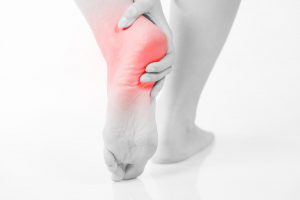
The foot is multifaceted system consisting of bones, ligaments, tendons and muscles that all work in unison to provide efficient shock absorption, propulsion in order for us to walk and run and it has to bear your body weight. There are two arches that predominantly absorbs the shock, and they are made up of bones that all fit into each other and are held together by ligaments. The muscles, fascia and fat pads provides additional support. Anything that affects these structures will result in pain. The body will then compensate in how it functions in an effort to reduce the pain which can lead to further injuries in the foot and even other parts of the body.
There are many causes for foot pain and these include infectious diseases (by viruses, fungi, bacteria), systemic diseases (diabetes, arthritis, gout), deformities (bone spurs, bunions, mallet toes, hammer toes), biomechanical conditions (flat or high-arched feet), improper footwear (high heels & very tight/poorly fitting shoes) and injuries (strains, sprains, bruises, fractures).
Symptoms that may accompany are swelling, redness, bruising, numbness/tingling, sharp shooting pain.
